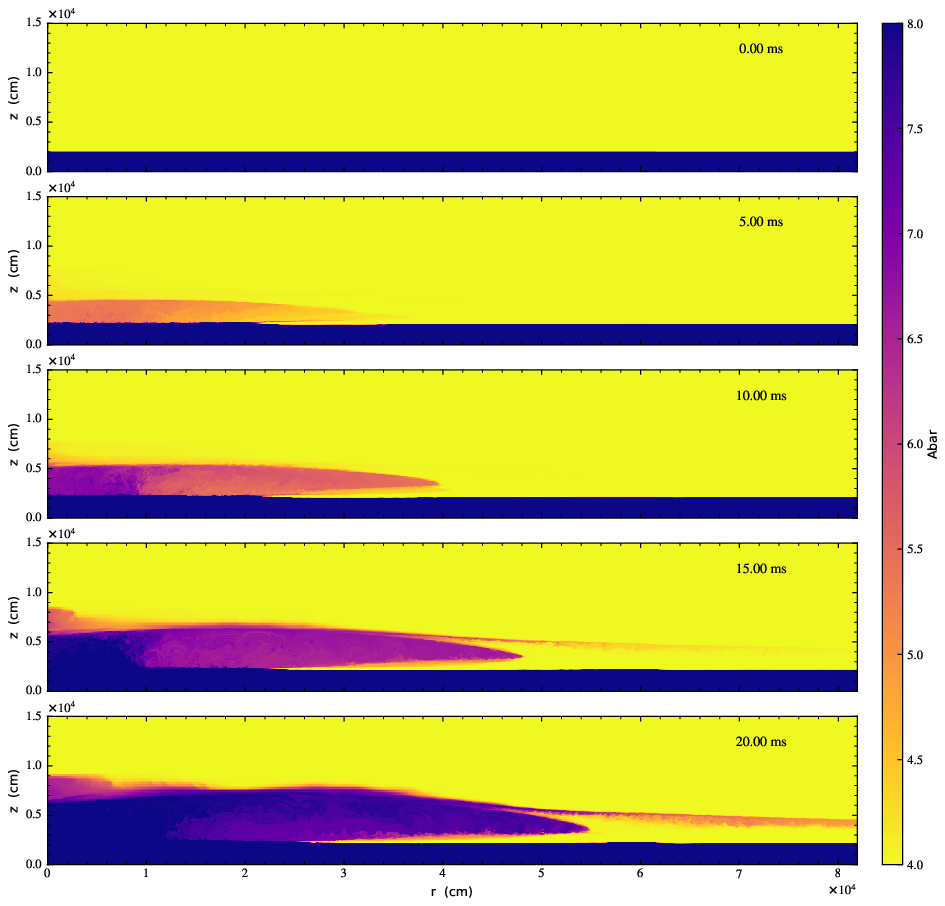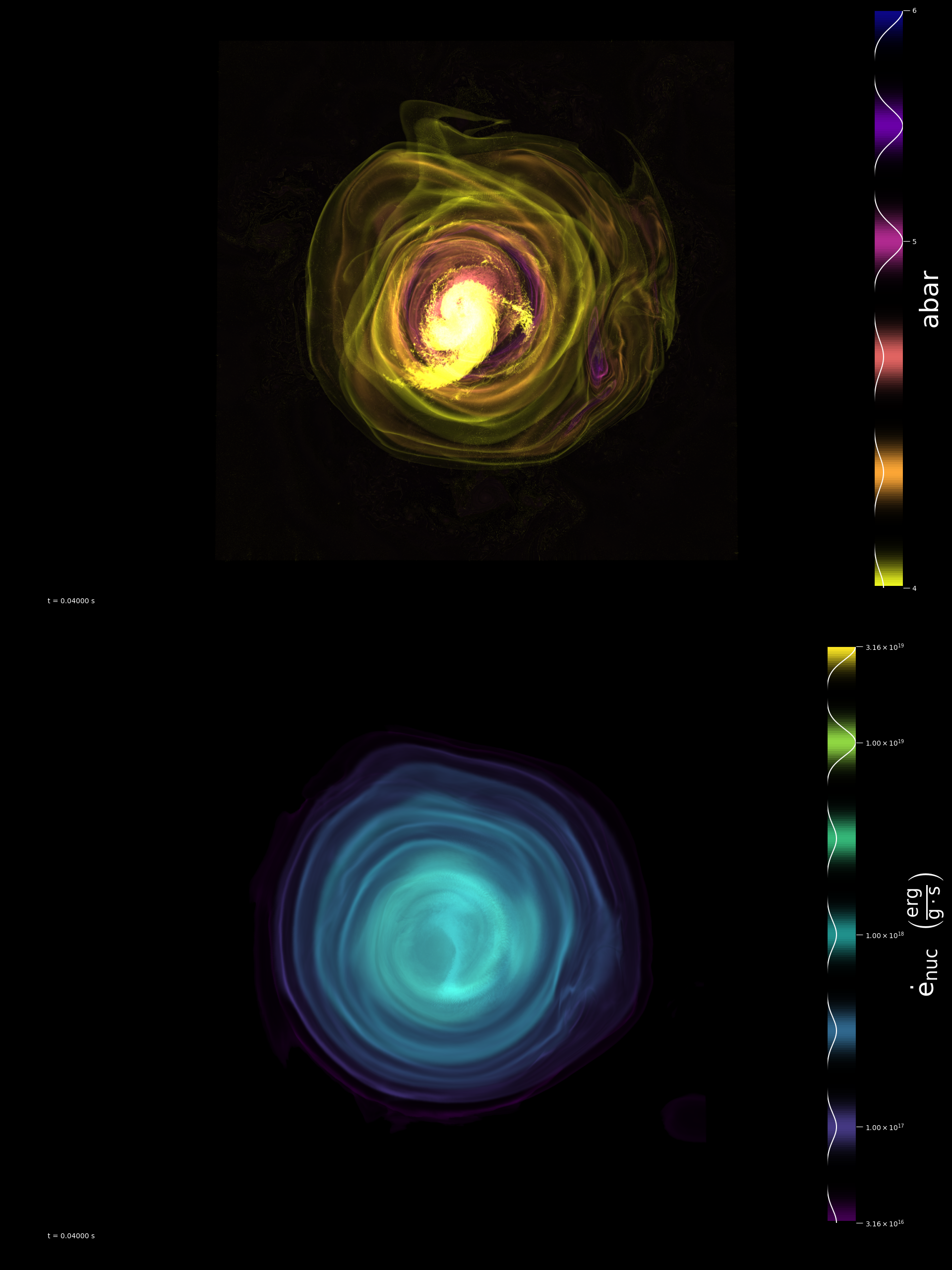Simulations of X-ray Bursts
Flame spreading in X-ray bursts
We are using Castro to model the flame spreading across the surface of the neutron star. Our simulations resolve the burning front and the Rossby length (the scale where the Coriolis force and lateral spreading balance), allowing us to model the development and propagation of realistic flames moving through the neutron star atmosphere. Realistic nuclear reaction networks and conductivities are used.
Our goal of these studies is to learn how fast these flames can acceleration, understand any multidimensional effects that might help explain burst oscillations, and to explore the nucleosynthesis.

A time-series of a pure He flame moving across the surface of a neutron star, from Eiden et al. 2020.

Volume renderings viewed from above of the 3D flame spreading simulation showing mean-molecular weight and nuclear energy generation rate, from Zingale et al. 2023.
Our results are described in the following papers:
- Dynamics of Laterally Propagating Flames in X-Ray Bursts. I. Burning Front Structure, Eiden, Kiran, Zingale, Michael, Harpole, Alice, Willcox, Donald, Cavecchi, Yuri, & Katz, Max P. 2020, ApJ, 894, 1, 6
- Dynamics of Laterally Propagating Flames in X-Ray Bursts. II. Realistic Burning & Rotation, Harpole, A., Ford, N. M., Eiden, K., Zingale, M., Willcox, D. E., Cavecchi, Y., & Katz, M. P. 2021, ApJ, 912, 36
- Comparing Early Evolution of Flames in X-ray Bursts in Two and Three Dimensions, Zingale, M. Eiden, K., & Katz, M. 2023, ApJ, 952, 160
- Sensitivity of He Flames in X-ray Bursts to Nuclear Physics, Chen, Zhi, Zingale, Michael, & Eiden, Kiran, 2023, ApJ, 955, 128
- Simulating Lateral H/He Flame Propagation in Type I X-ray Bursts, Johnson, Eric T. & Zingale, Michael, 2024, Journal of Physics: Conference Series, 2742, 1, p. 012005
Convection in X-ray bursts
We have modeled mixed H/He X-ray bursts with our low Mach number hydrodynamics code Maestro and its follow-on MAESTROeX.
In our original work, the nucleosynthesis was described by a 10-nuclei network that approximates hot-CNO, 3-alpha, and rp-process breakout. These simulations were done in a plane-parallel geometry, with a 6 cm resolution. These calculations followed on from our initial pure He simulations, with the goal of understanding how a multi-dimensional treatment of the convection alters the nucleosynthesis.
More recently, we've been exploring convection in models where the H and He are not mixed, but instead there is a He layer beneath a H layer.
Our results are described in the following papers:
- Multidimensional Modeling of Type I X-ray Bursts. I. Two-Dimensional Convection Prior to the Outburst of a Pure He Accretor, Malone, C. M., Nonaka, A. J., Almgren, A. S., Bell, J. B., & Zingale, M., 2011, ApJ, 728, 118
- Multidimensional Modeling of Type I X-ray Bursts. II. Two-Dimensional Convection in a Mixed H/He Accretor, Malone, C. M., Zingale, M., Nonaka, A., Almgren, A. S., & Bell, J. B., 2014, ApJ, 788, 115
- Comparisons of Two- and Three-Dimensional Convection in Type I X-ray Bursts, Zingale, M., Malone, C. M., Nonaka, A., Almgren, A. S., & Bell, J. B., 2015, ApJ, 807, 60
- Hydrodynamical Simulations of Proton Ingestion Flashes in Type I X-Ray Bursts, Guichandut, Simon, Zingale, Michael, & Cumming, Andrew 2024, The Astrophysical Journal, 975, 2, p. 250
Here's a model of the three-dimensional convection: